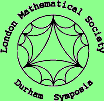 |
|
| Home | |
| Programme | |
| Short Courses | |
| Talks | |
| Posters | |
| For Presenters | |
| Participants | |
| Travel | |
| Recreation |
LMS Durham Symposium
Computational methods for wave propagation in direct scattering
Peter Bettess (Durham. UK)
Plane wave basis finite elements and boundary elements for scattering problems
Abstract
In recent years finite and boundary elements which include plane waves as well as the traditional polynomial shape functions, have proved very effective in modelling wave problems. Instead of the traditional 'rule of thumb' limit of 10 variables per wavelength, it has proved possible to model wave problems using very many fewer variables. In some finite element models the number of degrees of freedom has been reduced by up to 96\%, over conventional meshes. While in boundary element models the number of degrees of freedom per wavelength has been reduced from 10 to less than 3, at the same time retaining very accurate results. The additional complexities involved in using these models, will be discussed, in particular the complications of integrating finite element matrices which include the wave shapes. Some of the unexplained features of the methods, including the very high condition numbers and very accurate results!!, for both finite and boundary elements will be touched upon. Possible future developments will be outlined.